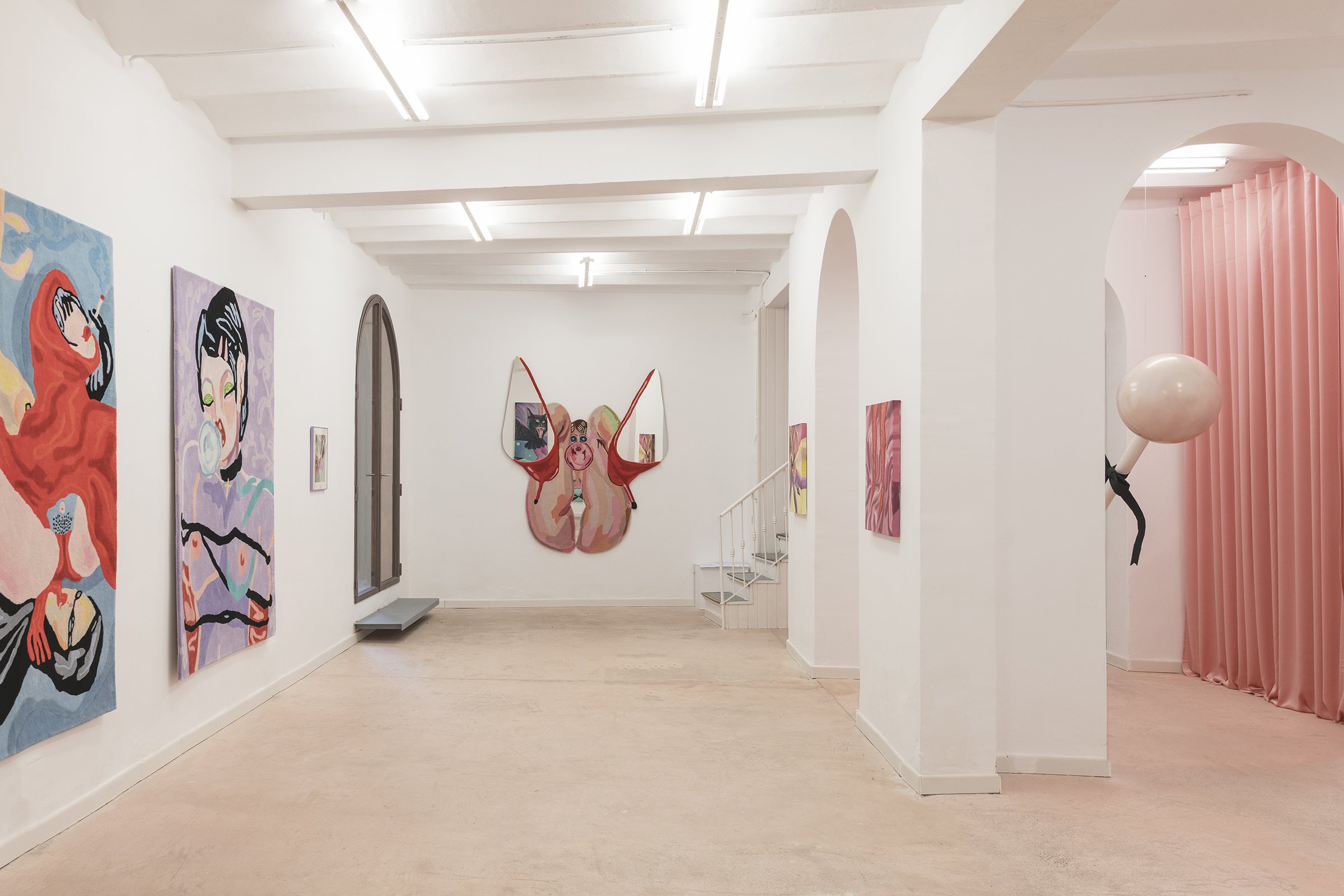
ausencia de tijera
miranda makaroff
MARCH - may 2025
Miranda Makaroff stands among those who have the freedom —and commitment— to create, among those who reject docility and attempt to navigate the interruptions of productivity and the mediocrity of everyday attitudes in life. Through a radical way of inhabiting the world, she has dedicated herself to creating a space of rebellion, happiness, and joy, under the premise of taking fun very seriously.
Her practice spans various formats and is oriented toward experimentation and the creation of a personal universe made up of paintings, drawings, tapestries, objects, interior design, and a public persona whose way of dressing, posing, and acting brings her close to the condition of a living sculpture, with great knowledge of the narrative power of fashion and the grammar of bodily gestures.
Her artistic work is an explosion of sensuality and eroticism. The art is characterized by the use of an energetic color palette of vivid and bright hues, with flat inks to create compositions of archetypal characters from her imagination. This takes a naïve and schematic graphic style that combines geometry with organic natural shapes. In this exhibition, the artist takes a further step in her concerns and moves away from limiting predeterminations to continue exploring.
In this new phase, Miranda reveals herself as more complex, contradictory, and vulnerable, delving into the realm of complementary and interdependent opposites: where attachment to the earthly, carnal, and desirous meets the contemplative and spiritual.
The new paintings and tapestries show explicit, irreverent images that delve into unconscious processes and portray liminal spaces that exist within us, blending individual experience with the collective unconscious, fantasy, and questioning of reality.
Makaroff has a fascination with the body, for its extraordinary nature, both profane and sacred. Anatomy contorts, and the erotic elements of the body fragment and juxtapose, with a tone that is both unsettling and playful. The work reclaims the carnal condition of the body and its manifestation through a desire that is both sensual and cosmic, presenting eroticism as a space of resistance against the dating of bodies and the inevitable death —as Bataille would say—.
The representation of hyperbolic femininity and seduction meets the ghostly, the soul’s concerns with the enigmatic. Makaroff seems to follow in the tradition of women who have been interested in the transcendent and the occult, using beauty and eroticism as a portal of access.
For the creation of these pieces, she draws on realistic references, personal photographs taken with her phone, intimate self-portraits with non-naturalistic perspectives, which she distorts and deforms through digital collages, adding a dreamlike treatment to claim the autonomy of female desire. In the final treatment, there is an approach to new painting techniques, which allow her to introduce depth and volume, as well as a restraint in the color palette, achieving a style more in tune with the specifics of carnality and the vertigo of existence.
The use of tapestries as a medium to weave some of the images accentuates their feminine and domestic character, while also generating tension between the mundanity of their utilitarian function and the provocative nature of the images represented. The spaces, like in dreams, appear blurred and diluted, but hint at their private character in an emphasis on representing intimacy and the magic of domesticity. There are direct allusions to fetishism, impossible stiletto heels, nods to bondage, crimson lips, and the bubble repeats as a symbol of fragility, growth, and enchantment.
This connection between materiality and symbolism runs through her personal history. Miranda grew up naturalizing the ability of clothing to be impregnated with emotions, to be decorative, functional, an element of control, authority, or liberation. She admired the talent of her mother, designer Lydia Delgado, for combining colors, patterns, and fabrics and for exploring the performative virtues of clothing. It was through the intuitive use of clothing and its transformative power that she began to flirt with subversion, eccentricity, and playfulness.
These works are a testament that the creative process is inseparable from the discovery of oneself, and culture is a safe space where, as adults, we can continue playing, building, and expanding identity through the intermittent adoption of roles. The artist uses creation as a space to rehearse the permanent and inevitable change that defines the human condition, adopting different versions of her performative and multiple self, and invites us to unravel that radical vulnerability, where existential rapture, defiant playful attitude, and resilience come together to reveal the exciting complexity of being.
Text by Maite Muñoz Iglesias
Curator and Researcher based in Los Angeles.
Pictures at Miranda’s studio by Sophie Chen
INQUIRE
Opening Hours
From Tuesday to Friday from 11am to 7pm.
Saturdays from 11am to 2pm.
C/ de Trafalgar, 32. Ciutat Vella, 08010 Barcelona
























